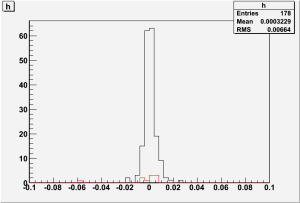...
Even though the MIP peaks are quite stable, there is still a possibility that since the MIP peaks are pedestal subtracted, downward trending pedestals could mask degrading tiles. However, the pedestals are also very stable (much more stable than the MIP peaks in fact), thus indicating that this is not the case. Below are histograms of the Pedestals (The left is in units of fraction of the pedestal per year, the right in raw PHA per year).
As can be seen above, there is very little drift in the pedestals at all, indicating that the MIP peaks are indeed stable, and are not being masked be pedestal drift. The data is again very Gaussian, indicating that slight drifts are due to noise, not actual degrading. The red boxes in the left histogram are the eight PMT's on the large tiles, indicating that the possible drift in the MIP peaks in these tiles is not apparent in the pedestals. Thus if the drift in those MIP peaks is indeed signal and not noise, the slight degrading is likely in the tiles, not in the electronics of the PMT. But again, there is no indication that it is large enough to worry about.

